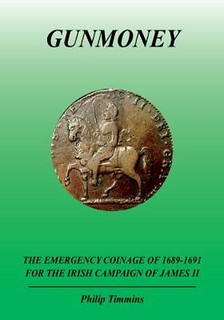
PREV ARTICLE
NEXT ARTICLE
FULL ISSUE
PREV FULL ISSUE
BOOK REVIEW: GUNMONEYSteve Blencoe submitted this review of the new book on Irish Gun Money by Philip Timmins. Thank you! -Editor
I have been a collector of the Gunmoney series for a few years now and have been frustrated by the lack of any reasonable reference. The papers and articles that have been published were contradictory. The most recent Spink reference, although a slight improvement on the last, was still lacking detail. I was very excited to hear about the new publication by Philip Timmins and was not disappointed when it finally arrived. The book was laid out in a way that I was not expecting, using a timeline rather than by denomination. An added bonus was the synopsis of the conflict which, for those not already in the know, must bring life to the series. A refreshing change to the normal humdrum numismatic references out there. The timeline of the Limerick mint was also tackled, and the conclusions drawn do make a lot of sense. Varieties in each denomination were tackled, and well illustrated where necessary. I am sure that as a result of the publication, many more varieties will surface from collections around the world. I imagine there will be some debate about what minor variations should constitute a separate reference. This has to be a good thing and no doubt an update to the reference will be published in a few years time detailing those new finds that surface as a result of this publication. I imagine that this is now the reference that will be used worldwide when identifying coins in the series, and quite rightly so. Jeff Rock submitted a review as well. Thanks! -Editor
The publication of a reference work on the intriguing series of Irish Gunmoney has long been needed – partially because the series is so darned confusing, but also because there has been so much misinformation published over the last 300 years that collectors for too long haven’t really known what was out there. This admirable work by Timmins certainly fills that need, and corrects much of errors of the past. The series was issued by King James II from 1689-1691 during his Irish campaign after he had been ousted from the British throne in the “Glorious Revolution” of 1688, mostly due to his embrace of Catholicism, but also over fear that he wanted to be an absolute monarch (his father, Charles I, didn’t fare too well in that role, having been executed in 1649). The Gunmoney series was issued in a multitude of metals – gold, silver, copper, white-metal and a brassy base metal (the most common). The coinage was issued in an even larger number of denominations – crown, halfcrown (in both large and small sizes), shilling (also in small and large sizes), sixpence, groat and penny. The coins were issued from 1689-1691, as mentioned, but are rather unique in the annals of numismatics since they were issued every month between June of 1689 and October of 1690 (a 1691 issue collected with the series was issued in Limerick) – and the coins not only bear the year of their mintage but the month as well! The month wasn’t an affectation on the part of the King, but rather a way to gradually replace the base metal coins with silver and gold if James II had succeeded – and, as an added bonus, the soldiers that served him would be able to not only exchange their base metal coins for silver and gold but also to claim interest on their wages, based on the date of the coinage. Since James II lost his bid to reclaim his crown this all came to naught – but remains an ingenious way to finance a war! Not all denominations or metals were issued in each month, and this has led to much of the confusion and uncertainty among collectors. Also adding to the confusion is that some issues were struck over earlier ones – but not over the same denominations. The smaller crowns, for instance, were struck over the earlier half crowns. Timmins tackles this problem in the logical manner, moving month-by- month, not only listing the denominations that were issued but also going into die varieties for each denomination. The die varieties are often subtle in nature, and the author makes the attribution easy by giving enlarged illustrations of distinguishing characteristics (usually in the crown and date detail on the reverse side. The only minor drawback of the book is that while each obverse die is illustrated in full, the reverse dies are not – only the enlarged portions to distinguish the dies. This certainly saved space and decreased printing costs, but it would have been nice to have even if it added a few more pages to the work. The photographs are in color, slightly enlarged, and are overall of good quality – which is nice since the series is often found in wretched condition, and having nice examples to compare to definitely makes attribution easier. Speaking of attribution, Timmins has devised a method that makes sense and is flexible enough to add new discoveries if they are made. The attribution numbers are a bit long, but there wasn’t any other option that combined utility and flexibility (simply numbering them from 1 to whatever the end of the series was has been proven the wrong way to do things ever since it was first used!). So a Timmins number may read: TB12B1-A. This number is basically shorthand for T(immins variety) B(ase metal) 12 (Shilling), June 1689 (the B) and Die Variety (1-A). The system is easy enough once you get the hang of it. The book is more than just a listing of die varieties, however. The introduction gives a history of James II’s Irish campaign and the reasons these coins were needed. Each monthly chapter starts with an update of what happened in that month to the King trying to reclaim a throne, and they are fascinating reading, even if you know how things eventually worked out. The listings of the varieties give all the information needed to easily attribute, and the author gives remarks where needed. Just as useful as an accurate listing of varieties is the addition of a rarity scale (a bit different than the American version, this one has a dozen points ranging from C3 (extremely common) to R7 (just one or two known), and includes the charming category of N – “normal, neither scarce or common” which is really something the Americans should think of including in the future). While not mentioned in the book itself, a fair number of Gunmoney coins have been found in archaeological contexts in North America, including in Colonial Williamsburg. Perhaps this is unsurprising since the British colonies here were often the dumping ground of coinage that was not wanted in England or Ireland. The William Wood coinage of Hibernia coppers may have circulated more in North America than in Ireland (especially after Jonathan Swift took aim at it), the 1760 Voce Populi coppers may have ended up here, and counterfeit Irish halfpence were sent here (along with their British counterparts) and are even found as undertypes for some of the early state coinages of the United States. The book is nicely printed, in Ireland of course, and is published by The Numismatic Society of Ireland. While shorter than initially expected – just 146 pages – each page carries its weight, and the author gives you everything you need to know to collect and enjoy this fascinating series. It is well worth the price, even when factoring in expensive postage costs from Ireland to the US. David Fanning has noted that he will soon have the book available in the US, and that should help bring the postage cost down to collectors on this side of the Atlantic. I was familiar with the series but have already learned a lot just from these reviews. Thanks! For ordering information, see the earlier article or contact David Fanning for
availability. See www.numislit.com . -Editor
To read the earlier E-Sylum article, see:  Wayne Homren, Editor The Numismatic Bibliomania Society is a non-profit organization promoting numismatic literature. See our web site at coinbooks.org. To submit items for publication in The E-Sylum, write to the Editor at this address: whomren@gmail.com To subscribe go to: https://my.binhost.com/lists/listinfo/esylum All Rights Reserved. NBS Home Page Contact the NBS webmaster 
|
